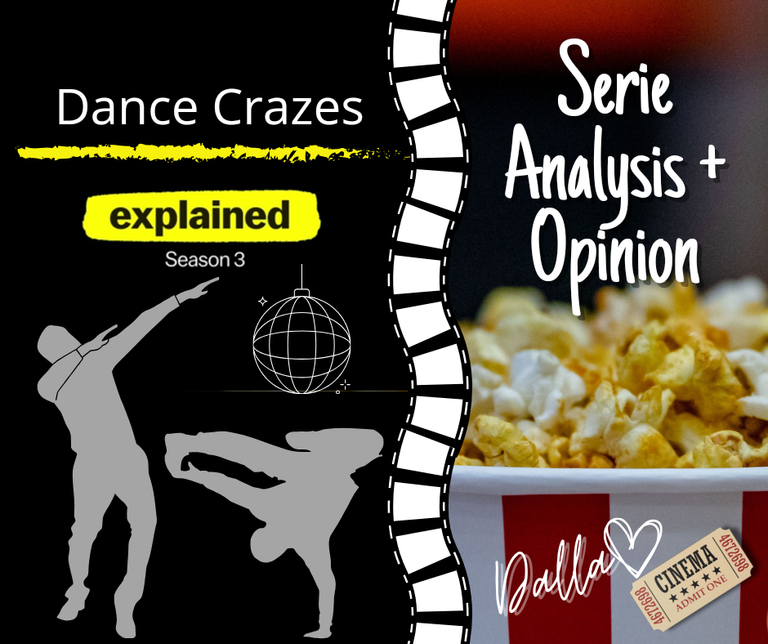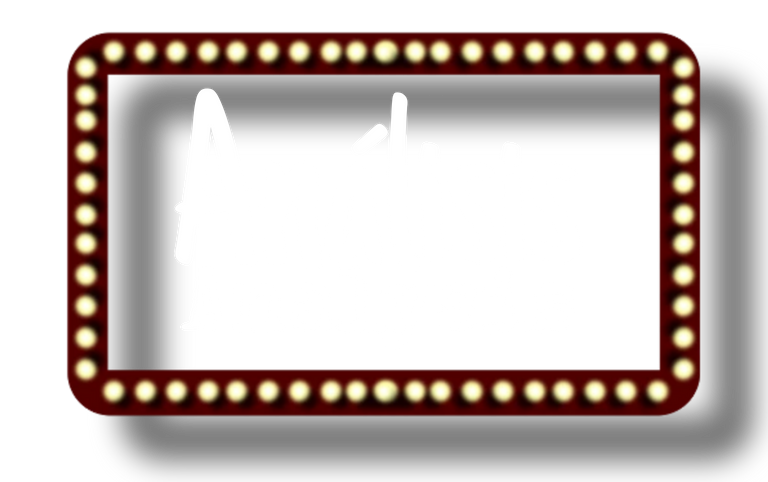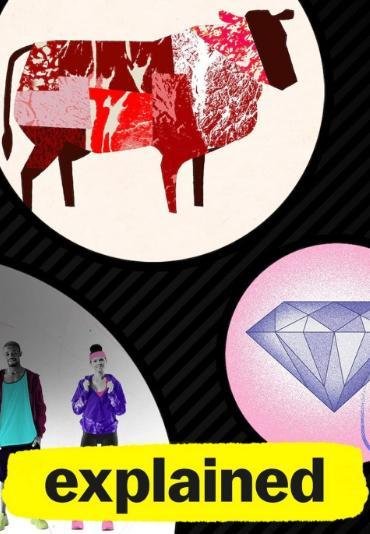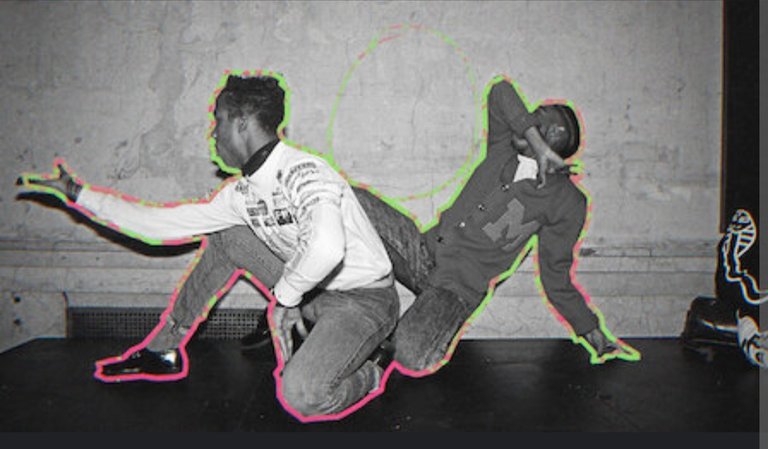Bailes de moda | Dance Crazes (Serie-Documental)


¡Saludos queridos espectadores del cine de Hive! el día de hoy continuando con el análisis de la serie-documental de Netflix, “La Mente en Pocas Palabras” o “Explained” por su título original en inglés, hoy les hablaré del capítulo destinado al análisis del Baile y su evolución a través del tiempo.

Les cuento que era un capítulo que no sabía si ver, ya que pensé que no sería algo que me atraería porque yo ni siquiera sé bailar jaja, sin embargo, terminó siendo bastante instructivo y me permitió analizar a profundidad la razón del por qué estos movimientos son tan necesarios en eventos sociales.
El documental comienza hablando del origen de estos movimientos coordinados al hacernos ver que el ser humano, si bien es el animal más desarrollado, es realmente muy pequeño anatómicamente y tiene un cuerpo muy frágil, a diferencia de los otros animales, por lo que una teoría evolutiva establece que el “Baile Social” surgió como una necesidad del ser humano de verse más grande ante sus depredadores, porque se realizaba en conjunto con otros humanos, de forma coordinada y de esa forma podrían protegerse de ellos al hacerlos ver como un solo animal muchísimo más grande.
Esto en particular me pareció bastante interesante, ya que nunca pensé que el baile de verdad tuviera un origen tan antiguo y arraigado en el ser humano; por otro lado, nos hablan de la evolución en el tiempo, de cómo el baile no es solo una forma de contacto entre 2 personas, sino que puede ser una forma de manifestar emociones, ideas, sentimiento e incluso demostrar la imaginación.
Nos hablan del baile como una forma de expresión, pero también nos habla del baile como una forma de mantener culturas a lo largo del tiempo, aun cuando estas se les intente oprimir, como es la cultura africana, por ejemplo, la forma como esta fue esclavizada, no se les permitió socializar y transmitir sus legados, hasta que llegó un punto de la historia donde la raza encontró la forma de transmitir su cultura y entre esos muchos medios convirtió el baile en uno de los principales.
Greetings dear viewers of Hive Cinema! today continuing with the analysis of the Netflix documentary series, "The Mind in a Few Words " or "Explained" for its original title in English, today I will talk about the chapter dedicated to the analysis of Dance and its evolution through time.
I tell you that it was a chapter that I did not know whether to see, since I thought it would not be something that would attract me because I do not even know how to dance haha, however, it ended up being quite instructive and allowed me to analyze in depth the reason why these movements are so necessary in social events.
The documentary starts talking about the origin of these coordinated movements by making us see that the human being, although he is the most developed animal, is actually very small anatomically and has a very fragile body, unlike other animals, so an evolutionary theory states that the "Social Dance" arose as a need for humans to look bigger to their predators, because it was performed together with other humans, in a coordinated way and that way they could protect themselves from them by making them look like a single much larger animal.
This in particular I found quite interesting, since I never thought that the dance really had such an ancient origin and rooted in the human being; on the other hand, they tell us about the evolution in time, how the dance is not only a form of contact between 2 people, but it can be a way to express emotions, ideas, feelings and even show imagination.
They speak of dance as a form of expression, but also speaks of dance as a way to maintain cultures over time, even when they try to oppress them, as is the African culture, for example, the way it was enslaved, they were not allowed to socialize and transmit their legacies, until it reached a point in history where the race found a way to transmit their culture and among those many means became the dance in one of the main ones.



Específicamente el documental se basa en analizar el baile social, explican cómo personas completamente diferentes pueden unirse a través de la práctica o visualización de este, como puede representar un medio para relacionarse entre ellos y convertir esto en una oportunidad para socializar.
Nos cuentan del surgimiento de los pasos de bailes emblemáticos a lo largo de la historia, como el famoso "Moon Walk" de Michael Jackson y cómo, a diferencia de la música, por ejemplo, el baile tiene muchas limitaciones para poder ser registrado como marca propia y es la razón por la cual es tan fácilmente reproducible en la población y se generaliza tan rápidamente, lo cual terminó siendo algo no necesariamente malo.
Hablan del baile como una plataforma para obtener seguidores en redes sociales, para conseguir ganancias económicas a través de la aparición en videos musicales o a través del surgimiento de los famosos "influencers" de las RRSS y cómo son capaces de monetizar a partir de estos movimientos, y las múltiples ventajas que se pueden obtener de él.
Pero siempre vuelven al inicio, a resaltar que el baile surgió como una forma de protección para el hombre, que en su forma más pura puede ser usado para demostrar dolor en rituales funerarios, para alabar a Dioses, para celebrar en familia o en grupos que comparten afinidades, y que es una forma de comunicación tan expresiva, que incluso puede representar historias para poder ser transmitidas de generaciones en generaciones.
Finalmente hablan de las ventajas de la práctica de él, como es despertar la empatía entre las personas, la comprensión, la comunicación, la sensibilidad y en general facilitar las relaciones sociales, lo cual, en la mayoría de los contextos, es algo completamente beneficioso.
Specifically, the documentary is based on analyzing social dancing, explaining how completely different people can come together through the practice or visualization of it, how it can represent a means to relate to each other and turn this into an opportunity to socialize.
They tell us about the emergence of iconic dance steps throughout history, such as Michael Jackson's famous "Moon Walk" and how, unlike music, for example, dance has many limitations in order to be trademarked and is the reason why it is so easily reproducible in the population and generalized so quickly, which ended up being not necessarily a bad thing.
They talk about dance as a platform to get followers on social networks, to get economic gains through the appearance in music videos or through the emergence of the famous "influencers" of the RRSS and how they are able to monetize from these movements, and the multiple advantages that can be obtained from it.
But they always go back to the beginning, to highlight that dance emerged as a form of protection for man, that in its purest form it can be used to show pain in funeral rituals, to praise Gods, to celebrate in family or in groups that share affinities, and that it is such an expressive form of communication, that it can even represent stories to be transmitted from generations to generations.
Finally they speak of the advantages of the practice of it, such as awakening empathy between people, understanding, communication, sensitivity and generally facilitate social relations, which, in most contexts, is something completely beneficial.



Todo esto lo describen mientras van demostrando diversos ejemplos de pasos de bailes emblemáticos a lo largo de la historia y como fueron, para el momento en que surgieron, realmente revolucionarios en su momento y muchos siguen siéndolo hoy en día.
Demuestran con varios ejemplos, como muchos pasos de bailes permiten reconocer a artistas, canciones específicas, movimientos culturales, razas e incluso épocas, por ello consideran que es una gran forma de expresión y comunicación.
Particularmente yo no bailo, no porque no me guste, sino porque en verdad nunca aprendí, pero reconozco que cuando veo determinados movimientos de baile con un ritmo determinado puedo comprender el significado, puedo sentir las emociones que me quieren transmitir, aun sin hablar, aun sin comunicarse de otra forma, por lo que realmente considero que es una de las principales formas de expresión artística.
Por todo esto que les acabo de decir, si tú no sabes bailar ¡te invito a hacerlo! a disfrutar de él y, por supuesto, a ver este capítulo de la serie documental Explained, que estoy segura de que te gustará, porque a mí, aunque en un principio pensé que no lo haría, terminó haciéndolo.
All this is described while demonstrating various examples of emblematic dance steps throughout history and how they were, for the time in which they arose, really revolutionary at the time and many remain so today.
They show with several examples, how many dance steps allow us to recognize artists, specific songs, cultural movements, races and even eras, so they consider it a great form of expression and communication.
Particularly I don't dance, not because I don't like it, but because I never really learned, but I recognize that when I see certain dance movements with a certain rhythm I can understand the meaning, I can feel the emotions that they want to transmit me, even without speaking, even without communicating in another way, so I really consider it one of the main forms of artistic expression.
For all this that I just told you, if you do not know how to dance, I invite you to do it! to enjoy it and, of course, to watch this chapter of the documentary series Explained, which I am sure you will like, because I, although at first I thought I would not, ended up doing it.




#hive #posh
https://twitter.com/DAQUIORX/status/1719069878487756814?t=VMW1xJlzETmhRogYkjVe2g&s=19
Hermanita, como es que no sabes bailar, y bailo merengue, bachata, tamunangue y algo de… No sé bailar salsa, se me olvida. Siempre he querido aprender a bailar tango, urbano y flamenco. Quizás algún día. El baile es un método recreativo, te distrae y divierte. Ve Doona.
Hermanitoooo no bailo nada, jamás aprendí, solo he bailado el vals en mis 15 años y una vez el alma llanera en bachillerato jajajaj, ah bueno, cuando me gradué fui a mi primera Disco y ahí bailé, ni sé que, en la oscuridad no se necesita saber... LA ESTOY VIENDOOOOO me acordé de ti porque sé que te gusta Suzy, la estoy amandooo, es muy nostálgica y me encanta la fotografía porque pareciera que estuviera leyendo el webtoon, además no conocía a ese actor y ahora estoy enamorada 😍😍😍😍😍 voy por el 8vo capítulo justo ahora:
Jajajajajaa tu y tus cosas. Debes aprender hermanita. Ademas te divertirias. ❤️ Yo no la he terminado, vamos a ver si la culmino hoy. La serie es muy buena. Yo si conozco el actor trabajó en varias series que m gustaron. 🙈